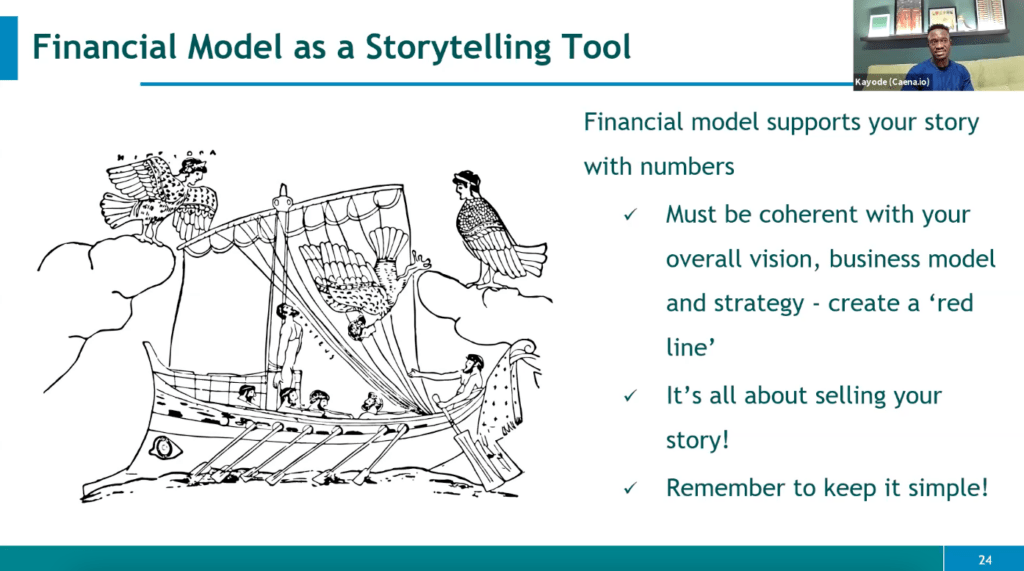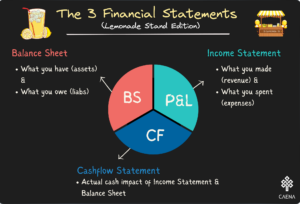Many startup founders view a financial model as just another (frustrating) requisite for raising funds.
Something they need to show investors; for pitch decks and grant applications.
“They’re wrong 95% of the time, so what’s the point?” is something we hear a lot.
It is important to realise that a financial model is more than just numbers on a spreadsheet. Internally, it is an operational tool: use it for decision making, budgeting and planning. It provides you and your team with a roadmap. And moreover, it is a storytelling tool.
The aim of a financial model is to communicate your vision, strategy and execution plan. It grounds your story in a financial reality, and supports your story with numbers. It gives you an opportunity to show investors (or whomever your audience is) how you will scale and how your will develop into a profitable venture. It tells where you’re going, how you’re getting there and most importantly: how you’ll make money, so investors can get a return on their investment (which we all know is what matters the most).
Your financial model should be optimistic, yet not unrealistic: investors also use it to gauge your assumptions and your understanding of the market you’re operating in.
Here are 5 tips on how to use your financial model as a storytelling tool:
5 tips on how to tell your story using numbers
1. Visualise it!
While you will need to have the full output in Excel spreadsheets, or whichever format the investors prefer, your deck should visualise your financial data. After all, investors are also human beings, and a visualisation that gives a good overview of your numbers is something everyone likes to see. Highlight the most important parts of your graph and make them stand out, either by contrasting or making them in a signalling colour). For further reading, I would recommend Slideology by Nancy Duarte.
2. Alignment – Make it a part of the ‘bigger picture’
Your financial model is not a stand-alone component – it is an extension of your story. The elements in your pitch deck, including your projections, all needs to be aligned, so that there is a ‘red line’ throughout your story. This means that your financial model should reconcile with both your vision, business model and strategy.
3. Know your audience
Nailing your messaging is one of the most important things for a startup’s success. As with all messaging, it needs to be tailored to your audience. How you present your story and your financial model will depend on who you’re pitching it to. Try get into the mind of your audience and understand what they care about. This doesn’t mean you need a different financial model for each audience – but it means you model should be flexible and easily tweaked, and it means what you highlight and focus on in your pitch will differ, depending on who’s your audience.
4. Keep it simple!
Focus on the key metrics investors (or your other audience) want to see and care about. Don’t make it superfluous, that will just complicate your story.
5. Include the key components of a story: Setup, Conflict, Resolution
According to Harvard Business Review, every story should contain three elements:
- Setup
What’s the reality you’ve created for the story? This is the ‘before’ state of the data - Conflict
What’s the conflict that change this reality? This is how the data changes. Ask yourself what is causing the change - Resolution
What’s the new reality the change creates? This is the ‘after’ state that the change results in
Remember to highlight the main points; the most important information. You can leave out the rest, or you risk a bored audience!
Remember: Getting funded is all about your ability to sell your story, and a good financial model helps you do that!
Webinar – “Startup Fundraising: Selling your vision effectively with Financial Data”
If you want to know more about how to use your financial model as a storytelling tool, we hosted a Webinar with TechCitizen and Entrepreneur Academy on November 11th. Watch the recording here: https://www.youtube.com/watch?v=uC4YeKnBMBQ&t=888s

Need Help Building Your Model?
While we can’t help you tell your story, our financial modelling tool can certainty help you build your financial model.
With Caena, early-stage founders like you can create a financial model (incl. graphs and charts) in less than 30 minutes. The best part? No financial know-how or spreadsheets/Excel needed. Try for Free Now





